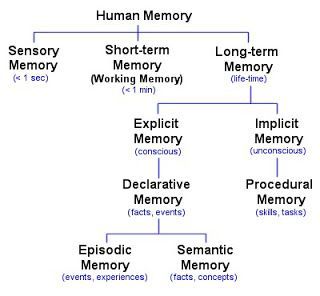Memory is an essential component to understanding our behavior. Learning associated with experience provides the clearest model. Memory is coincident with the formation of semantic maps of experiences. Higher learning, as by instruction in school, is described experience, not direct experience; nevertheless, the process of remembering the ideas, theories, and facts are also semantic maps, but there is less assurance with the memory since it is related rather than experienced.
Memory Reconstruction
Memory is not a perfect recording of events from the past; indeed, it is actually a reconstruction of past events. A particularly striking demonstration of the inaccuracy of eyewitness testimony comes from dozens of cases in which those convicted of serious crimes were freed from prison because DNA evidence proved they were not guilty. In most of these cases, the individuals had been convicted on the basis of eyewitness testimony.
Past Begets Present
Past experiences are engraved in the synaptic efficiencies of specific pathways, so that in addition to conscious recall, new experiences are processed through neurons whose synapses reflect previous experiences.
Mental Construction
Aristotle explained actions by levels of causation (or explanation)—material (substance), formal (form of material), efficient (agent responsible for change), and final (purpose of change). However in Mental Construction, human actions are caused or explained by different levels:
- Psychological. A person has needs, wants, desires, and goals. They explain why a person makes a specific behavioral choice.
- Genetic. A person’s psychological drives arise from genetic heritage, both common across humanity and specific to that individual.
- Environmental. A person’s psychological drives arise from that person’s experiences.
- Cultural. A person’s choice of behaviors is molded by the mores of the society he or she is raised in.
- Linguistic. A person’s behavioral repertoire is guided by the categories the language recognizes. For example, voluntary muscle movement is based on the assumption that certain actions allow choices.
- Brain neurons. A person’s behaviors can be understood by observing the characteristics of brain neurons.
I am adding a few explanations that link the brain’s neurological function to the other levels. Specifically, the Almost Gate explains how we continue to think psychologically despite limited information and the time pressure to make a decision. The Concept Elevator is a useful metaphor for the increasing level of concept abstraction that accompanies the transfer of categories away from sensory receipt up to prefrontal decision-making. Each step and each floor up the concept elevator passes with a loss of fidelity due to the Neural Cascade, which introduces an indeterminacy into our internal worldview.
Memory
But let’s come back to memory. As Alan Baddeley says in Your Memory (p 10-11), discussing the physical basis of memory, the final aim of giving a physiological account of psychological facts.… However, many of the claims for an understanding of the molecular basis of memory … have been shown to be premature. … There is no doubt progress is being made in this important area, and that one day there may be a very fruitful collaboration between the experimental psychologist and the neurochemist. Today, however, there is little area of overlap.

Memory in Figure 1 arranges the various types of memory into a hierarchical structure.
- Sensory memory has three main subsystems. Sensory data can have a lag of 1/2 second or more until it is registered by the brain. These subsystems retain that much sensory input supporting continuity of sensation as well as allowing attention (or inattention) to further analysis.
- Visual sketchpad
- Phonological loop
- Haptic (touch)
- Short-term and working memory may or may not be the same thing.
- Short-term memory is the gateway to eventual long-term memory.
- Working memory provides the arena for a number of thoughts, facts, and theories to be considered together.
- Long-term memory is what is commonly referred to as memory. It has its own distinct components.
- Explicit memory (declarative memory) is the repository of consciously remembered facts.
- Episodic memory contains memories of our life events.
- Semantic memory is store of our learned facts, concepts, theories, etc.
- Implicit Memory (procedural memory) holds the skills of routine behaviors and tasks we have mastered. Tying our shoes or riding a bike without conscious attention to the activity are examples of using procedural memory.
- Explicit memory (declarative memory) is the repository of consciously remembered facts.
